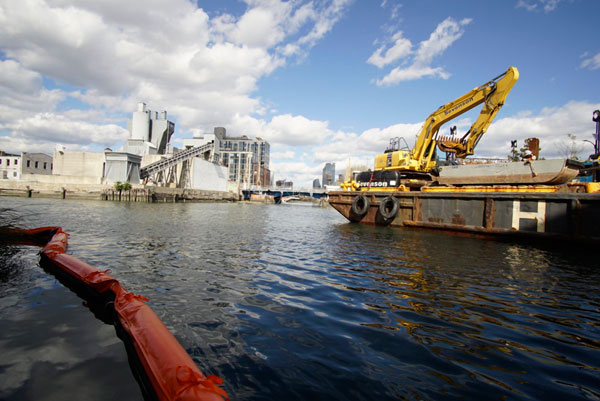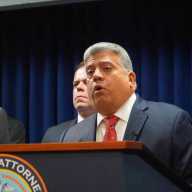It’s a tar-iffic development.
Workers will resume cleaning the Gowanus Canal next week now that polluters responsible for the cleanse are finally starting to meet the Environmental Protection Agency’s deadlines, according to the man in charge of the effort.
“We are at the point where you will be seeing work taking place in the canal,” said Christos Tsiamis, the agency’s project manager.
Barges will float into the toxic waterway’s Fourth Street Turning Basin at the intersection of Fourth Street and Third Avenue on Oct. 5 to kick off a pilot study that will test dredging in the stretch, according to Tsiamis, who spoke at a Sept. 26 meeting of the Gowanus Community Advisory Group, a stakeholder panel overseeing the cleanup that began nearly a year ago.
Workers will then use equipment to dig up the canal’s floor, making it deeper so the actual dredging can take place. By December, they’ll get to work dislodging noxious black sediment from the depths of the waterway, removing it, and then capping the bottom of the channel to prevent other toxins from seeping in.
Some portions of the extricated sediment will be used as cover material in landfills, and chunks containing too much liquid tar will be sent to facilities that will burn them away.
The dredging will take approximately two months and will be followed by the capping, which is expected to wrap by April, according to Tsiamis.
The news was a turnaround from the project manager’s May announcement that polluters including National Grid, Honeywell, and Amerada Hess refused to follow the Feds’ timeline for submitting cleanup plans, forcing the Environmental Protection Agency to begin issuing them penalties. There was no way the cleanse would finish on schedule by 2022, Tsiamis said at the time.
But he said on Tuesday that polluters’ recent cooperation allowed cleanup teams to get a lot of work done over the summer.
Tsiamis also updated attendees on what caused some bulkheads lining the side of the canal to collapse into the waterway in May and July, revealing that the infrastructure crumbled due to a combination of old age and bad weather.
His agency recommends that owners of the properties where the stretches of wall sit restore them over the full length of their land in order to stop more bulkheads from falling into the black mayonnaise below, he said.
“Those bulkheads are not in good shape so there’s a potential of future collapse,” Tsiamis said.
The project manager did not give a new end date for the Superfund site’s long-awaited cleanup, but an agency spokesman said officials will have a better idea how long it will take after the pilot dredging work is done, because honchos should then be able to assess how quickly the sludge can be scooped out.





















